Best tourist places to visit in Madhya Pradesh: Khajuraho, Kanha, Orchha
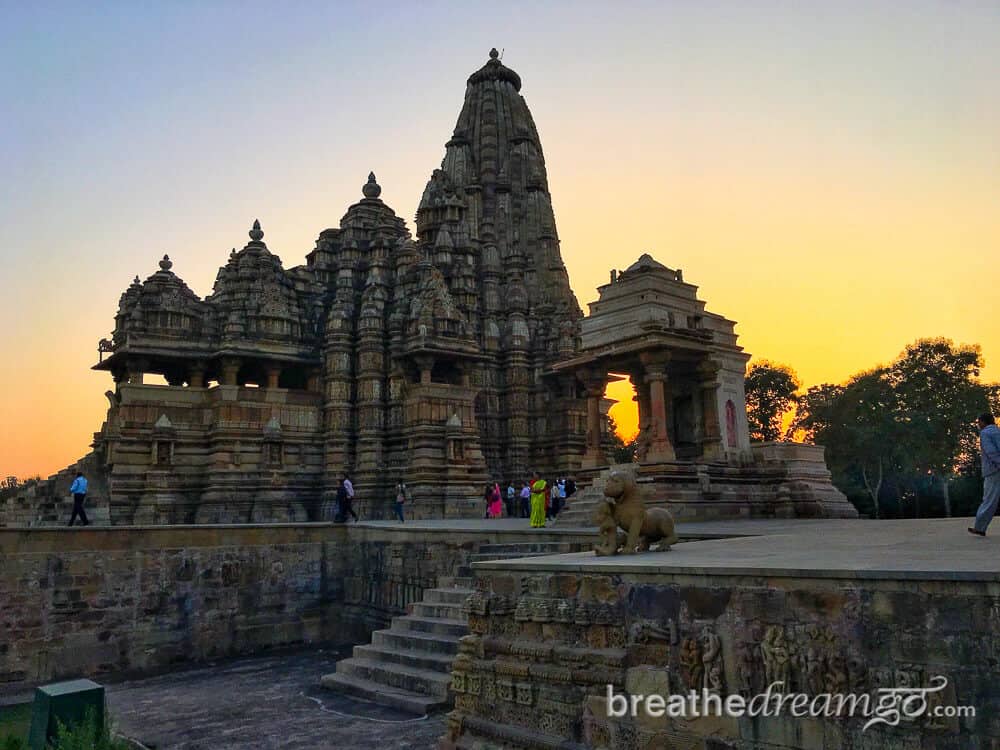
Gorgeous Khajuraho glows with sublime beauty at sunset
Table of Contents
Madhya Pradesh tourism is on the rise with treasures like the Khajuraho Temples, Kanha National Park, and beautiful Orchha
Madhya Pradesh has some incredible treasures throughout the state, such as Khajuraho Temples, Kanha National Park, Orchha, Bandhavgarh National Park, Maheshwar, Gwalior Fort, Mandu, and Bhopal. Situated right in the centre of India, the heart of India, this state is one of the most interesting places to visit in India — and one of my absolute favourite states.
Madhya Pradesh tourism is on the rise, due to the fact there are three UNESCO World Heritage sites, some of the best tiger reserves in India, the most beautiful temples and forts, fascinating and historical cities like Orchha, Bhopal, Gwalior, and Indore, and greenery – MP still has about 40% forest cover and some of the best national parks and tiger reserves in India. These are some of the best places to visit in MP, Madhya Pradesh, but really … I am only scratching the surface of one of my favourite states in India.
More reading on Breathedreamgo about travel in India
- If you are planning to travel in India, our India for Beginners custom tours are perfect for first time visitors.
- In our post on Taking the train in India, you will learn everything you need to know about booking and travelling on trains, planes, buses, taxis, rickshaws and more
- Get tips on packing for India.
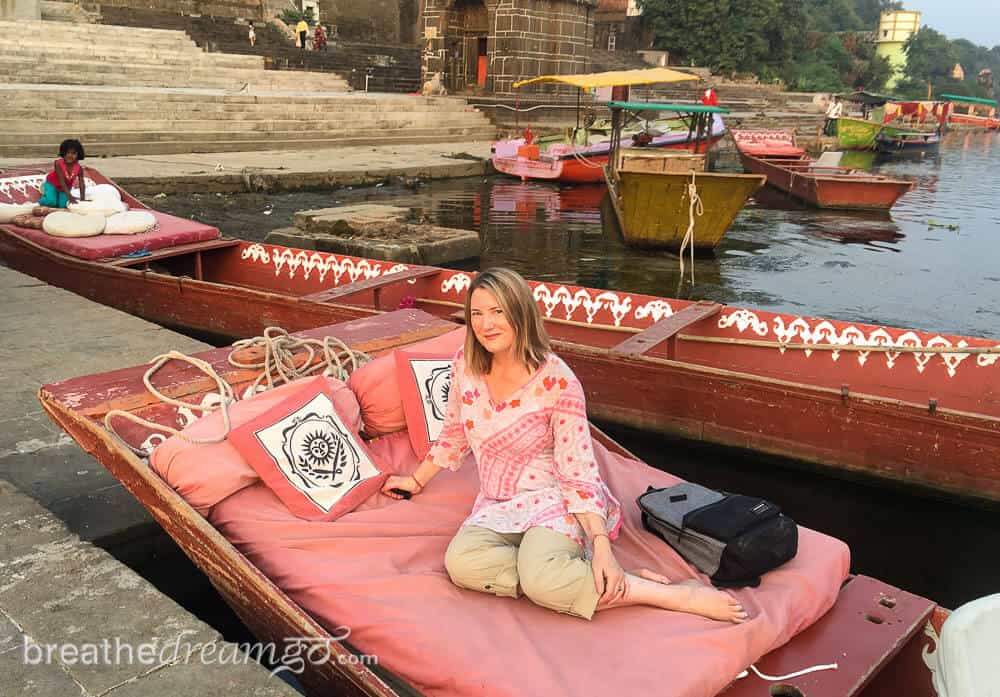
All ready for a sunset boat cruise on the Narmada River at Maheshwar.
So here they are, some of the best tourist places to visit in Madhya Pradesh based on my travels there over the past two years.
- Khajuraho Temples
- Kanha National Park
- Bandhavgarh National Park
- Orchha
- Maheshwar
- Gwalior Fort
- Mandu
- Bhopal
- What you need to know
- How to get there
- Best time to visit
- Where to stay
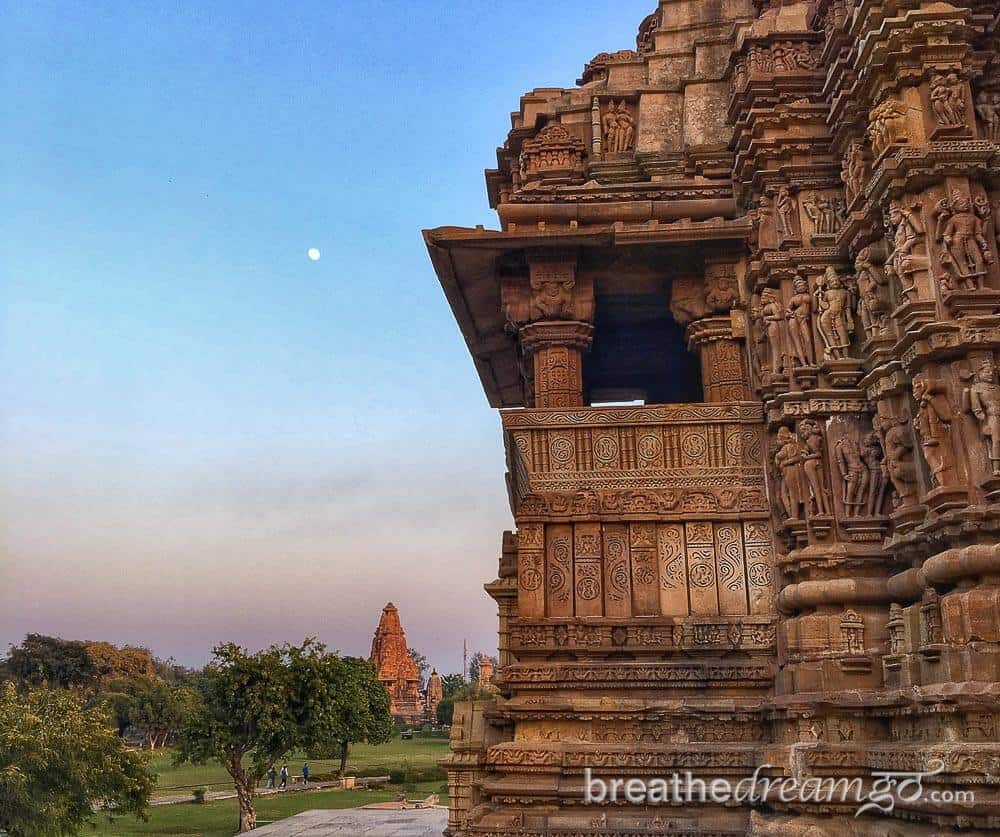
Full moon over beautiful Khajuraho
Khajuraho Temples
Eternity carved in stone is the best way I can think of to describe the temples of Khajuraho. Many consider them to be the finest temples in India in terms of both the sophistication of the architecture and the quality of the carvings. I’m not an expert, but I can tell you that I was transported. The temples exceeded all of my expectations and I consider them to be among the top wonders of India, equalling the Taj Mahal, Hampi, Fatehpur Sikri and others. The best temples are in the Western Group of Monuments, which requires an entrance fee. There is also a sound and light show here each evening that is worth seeing.
Khajuraho is of course famous for the “erotic” carvings that form part of the art on several of the temples. There are numerous explanations for their presence. Some think they illustrate the Kama Sutra. Personally, I liked what my guide, Govind, said about them. He’s been working as a guide at Khajuraho for 20 years. He said the figures — even in wild, acrobatic and bestial couplings — are neither erotic nor obscene. He said they are Mithuna figures and they represent divine love, the union of Shiva (male) and Shakti (female) energies. They are among thousands of carvings of people engaged in various acts of life such as fighting, dancing, eating, hunting. Devotees visiting the temples were to reflect on all aspects of life as they did their rounds and rise above them in spiritual ecstasy.
Not only do I love the Khajuraho Group of Monuments, which is listed as a UNESCO World Heritage site, I also love the town of Khajuraho. Except for the assertive touts and rickshaw drivers who ply the road in front the Western Group of Monuments, it’s a very charming and laid-back small town. I could spend the entire day upstairs at the Raja Café, which forms a kind of treehouse, overlooking the pedestrian road that runs along the Western Group of Monuments. Food is good at the Raja Cafe, too!
What you need to know: The temples are open sunrise to sunset. There is an entrance charge for the Western Group of Temples (INR 500 for foreigner tourists, INR 30 for locals). You can watch the spectacular Sound and Light show in the Western Group of Temples after sunset, for a separate fee.
How to get there: You can fly directly to Khajuraho from Delhi or Varanasi or take a train.
Best time to visit: Madhya Pradesh gets hot, so anytime between October and March would be ideal.
Where to stay: For the budget conscious, Zostel has a lovely hostel in a prime location. At the higher end, you can’t beat The Lalit with view of the Western Group of Temples right from some of the rooms and the swimming pool.
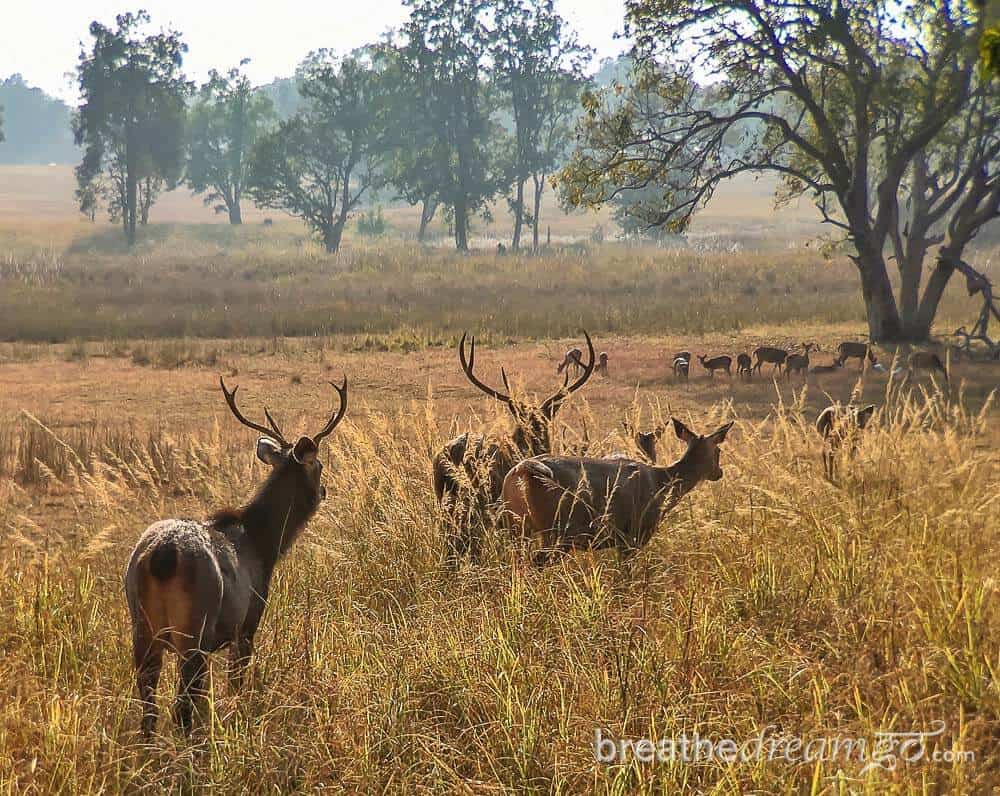
Barasingha hard-ground swamp deer at Kanha National Park
Kanha National Park and Tiger Reserve
Kanha National Park is one of my favourite places in India. It’s not only a great place for wildlife and tiger sightings, it’s a spectacularly beautiful park that is also extremely well-managed. I’ve been to Kanha several times, and I never tire of getting up before dawn to go for the morning safari. No matter what happens, when those park gates open, you know you are going to have a wonderful morning. There’s the thrill of the chase, of course, as your guide and naturalist attempt to show you a tiger. But it doesn’t matter if you don’t see one. There is so much else to see.
Kanha is a bird lover’s paradise, and it’s also full of animals such as chital, gaur, dhole, jackals, sloth bears, and the magnificent barasingha. The barasingha hard-ground swamp deer was almost extinct until Kanha organized a captive breeding program. Now you can see large herds of them grazing in the park’s gorgeous meadows.
Kanha is one of the busiest and most-sought after national parks and tiger reserves in India, and you have to book well in advance (120 days or more) to secure a Gypsy (jeep) booking during high season, from December until May. Last year, the entire month of March was sold out. At 940 square kilometres in the core zone, and 1,009 square kilometres including the buffer zone, Kanha is the largest park in Central India – but only about 20% is open to tourists. Kanha has two main gates, Katia/Kisli and Mukki, and five zones: Katia, Kanha, Kisli, Mukki and Serai. There are lodges clustered near each gate, in every price range, and some excellent places to stay. I always recommend booking a lodge based on the quality of the naturalists more than any other factor – a good naturalist will make your safari.
You can read more in my Guide to Kanha National Park, and the four lodges I recommend – both for their naturalists as well as their ambience, service, and commitment to sustainability.
What you need to know: Kanha National Park is open from October 16 to June 30. It is recommended that you book your safari tickets at least 120 days in advance.
How to get there: You can fly to Jabalpur, Nagpur, or Raipur and drive, depending on whether your lodge is at the Katia/Kisli gate or the Mukki gate.
Best time to visit: When the weather heats up in March, April, and May, tiger sightings are at their peak as they are drawn to the waterholes. Winters can be very chilly, especially morning safaris.
Where to stay: Pugdundee Safaris Earth Lodge is my top choice, followed by Singinawa, Bagh Villas, and Kipling Camp.
If you want to explore the national parks and tiger reserves of Madhya Pradesh, check out the Breathedreamgo Wildlife and Tiger Safari custom tours, offered in partnership with Pugdundee Safaris.
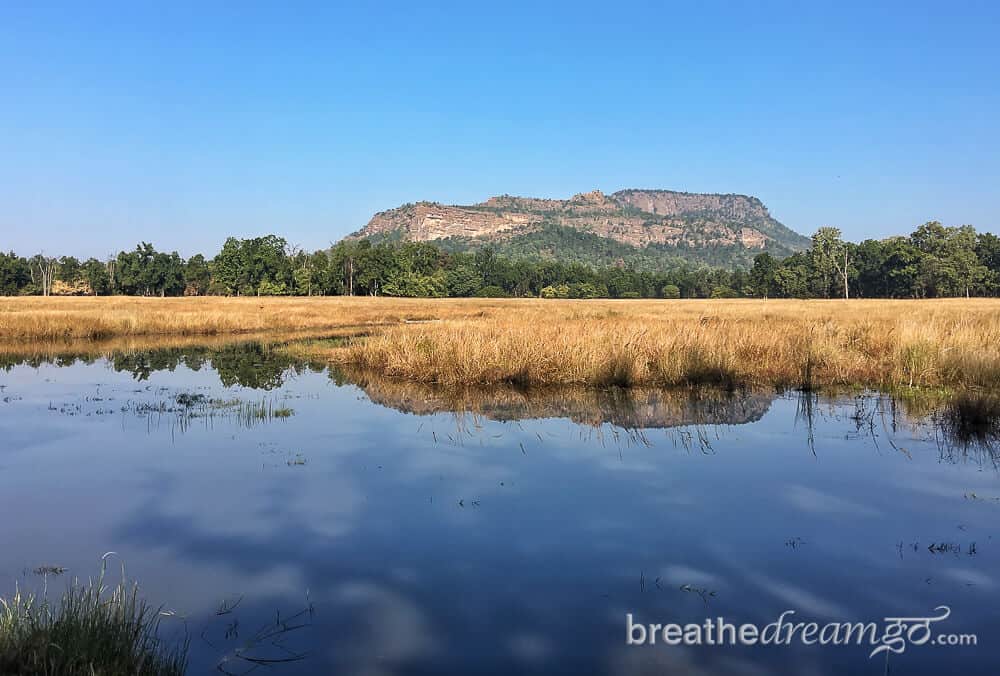
Bandhavgarh National Park and Tiger Reserve is named after this hill, in Tala Zone
Bandhavgarh National Park and Tiger Reserve
On this recent trip to Madhya Pradesh, an overnight train ride on the Narmada Express took me to Bandhavgarh National Park, where I stayed for four nights at Pugdundee Safaris Kings Lodge. I explored the local villages and went on two wildlife and tiger safaris with locally born-and-raised naturalist Naresh “Gudda” Singh, and saw five tigers: Dotty and her three cubs and Bheem.
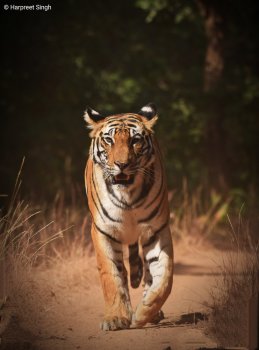
Dotty strolling in Bandhavgarh. Photo Credit: Harpreet Singh
Bandhavgarh is the state’s second most popular national park and tiger reserve. Not as big as Kanha, it is easier to spot tigers in Bandhavgarh. In fact, it is considered by many to be the best place for tiger sightings in India. I also love this park, and like, Kanha, I have seen a tiger every time I have entered it. I remarked to one guide that I was very lucky to see so many tigers, and he said, “Maybe they want to see you!” A very charming thing to say, and typical of the friendly people I always meet in these natural places.
Bandhavgarh has three gates and three tourist zones: Tala, Magdhi, and Khitauli. The core zone of the park is 450 square kilometres, but the tourist area is restricted to 105 square kilometres. Sal trees and bamboo dominate, giving the park a lush atmosphere. Tala zone is considered the most picturesque, here you will see Bandhavgarh Hill after which the park is named, and the outlines of an ancient fort that sits on top. The region is rich in history and legend, associated with the Ramayan – in fact, Bandhavgarh means “brother’s fort.” It was formerly a game reserve for the Maharajas of Rewa until 1968 when it became a state park.
Check out my Guide to Bandhavgarh National Park and everything you need to know to visit, and also where to stay.
What you need to know: Bandhavgarh National Park is open from October 16 to June 30. It is recommended that you book your safari tickets at least 120 days in advance.
How to get there: You can fly to Bhopal and take a train to Umaria. Or fly to Jabalpur and drive.
Best time to visit: When the weather heats up in March, April, and May, tiger sightings are at their peak as they are drawn to the waterholes. Winters can be very chilly, especially morning safaris.
Where to stay: Pugdundee Safaris Kings Lodge or Treehouse Hideaway are my top choices. A more budget conscious choice would be Bandhav Vilas. At the very high end, Taj Safaris has a beautiful property, Mahua Kotha. And the Samode Safaris Lodge is heavenly.
Comments
Post a Comment